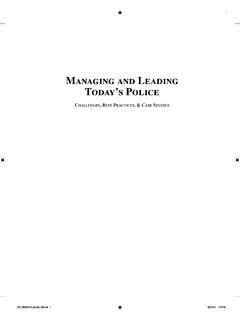Transcription of INCLUSIVE LEADERSHIP
1 INCLUSIVE LEADERSHIPT heoretical framework ENThis publication has been funded with support from the European Commission. This publication reflects the views only of the author, and the Commission cannot be held responsible for any use which may be made of the information contained : The manual was prepared by alp activating LEADERSHIP potential, along with valuable contributions from the project partners, in particular from Maria Makowska, School for Leaders Foundation in Poland and from Michael Kraack, Heike Kraack-Tichy and Anna Sharapova from the EU-Fundraising Association e. V. in Germany. We would like to acknowledge the work, contribution and feedback from the experts and trainers who participated in the different stages of the and final editing: Irene RojnikAuthors: Paola Bortini, Angelica Paci, Anne Rise, Irene RojnikLayout and design: Adam Paluszkiewicz ( )This manual can be downloaded and used free of charge under the terms of the Erasmus+ manual is subject to the licence: Creative Commons Attribution NoDerivatives Version (CC-BY-ND, ).
2 Reproduction is authorised provided that the source is acknowledged. Picture credits: Fundacja Szko a Lider w: photos on pages 1, 4, 6, 8, 9, 10, 11, 13, 15, 16, 17, 22, 26, 28, 31, 37, 40, 42 alp: photos on pages 7, 23, 34 Pawe Cie lak: photo on page 11 Eva Maria Henning-Bekka: photo on page 43 Pictures from image databases used under the Creative Commons Zero (CC0) license: (photos on pages 16, 21,25); (photos on pages 18, 39, 41). INCLUSIVE LEADERSHIP the new attitude towards the reinforcement and the development of the members of disadvantaged groups. 2016-1-PL01-KA204-0267683 Table of Contents Introduction ..4 LEADERSHIP through the Ages ..6 INCLUSIVE LEADERSHIP - a New Dimension in LEADERSHIP theories ..10 Needs and Barriers with INCLUSIVE LEADERSHIP .
3 13 Benefits of INCLUSIVE LEADERSHIP ..16 The Foundations of the INCLUSIVE LEADERSHIP Approach..18 Ad 1) The acknowledgement and value of everybody s inherent worth .. 19 Ad 2) An approach based on human rights .. 19 Ad 3) Awareness of interconnection .. 20 Ad 4) The role of power in INCLUSIVE LEADERSHIP .. 20 Ad 5) Courage to share and take over responsibility.. 22 The INCLUSIVE LEADERSHIP Approach..23 The Development Areas for INCLUSIVE LEADERSHIP ..26 Development Area 1: Practising Self-Awareness .. 27 Development Area 2: Living a Shared Vision .. 30 Development area 3: Building Relationships .. 33 Development Area 4: Creating Change.. 36 Impact of INCLUSIVE LEADERSHIP ..39 Conclusion ..41 References ..43 Introduction5 IntroductionThis handbook is intended to be an inspirational source on the topic of INCLUSIVE LEADERSHIP for practitioners who are working alongside or leading others at risk of being excluded from society.
4 Current concepts of INCLUSIVE LEADERSHIP focus on very broad and diverse target groups. The term is used to include everyone people with different cultural backgrounds, experiences and ways of working, ages, sexual orientations or genders, physical abilities etc. This handbook focuses on individuals and organisations and includes those at risk of being excluded from society because: They have some form of disability They have a migrant or refugee background or They have less access to information and facilities because they live in remote areasThis does not mean that the knowledge and practices proposed in this handbook cannot be applied to other people or in other contexts. This only means that the knowledge and practices proposed in this handbook focus on the target group mentioned above and that the leaders working with individuals at risk of exclusion were actively involved in the development of the handbook.
5 All of the examples in the handbook stem from the target group mentioned INCLUSIVE LEADERSHIP approach presented in this manual is based on the human rights laid out in the Universal Declaration of Human Rights, since this forms the basis for any human interaction. Furthermore, this approach builds on the belief that everything is connected and that INCLUSIVE leaders need to be aware of the world in which they live and its resources. Practising INCLUSIVE LEADERSHIP can contribute towards solving both small and big challenges in our complex world today. INCLUSIVE leaders appreciate everybody s contribution and inspire innovation by involving people at risk of being excluded from society. They are prepared to give up power, share responsibility and tap into the wisdom of the group in order to benefit everyone - the leader, the follower and the society.
6 INCLUSIVE LEADERSHIP means having the courage to take conscious steps to break down barriers for people at risk of being excluded from leaders embody a LEADERSHIP approach that appreciates diversity, invites and welcomes everyone s individual contribution, and encourages full engagement with the processes of decision-making and shaping aim of INCLUSIVE LEADERSHIP is to create, change and innovate whilst balancing everybody s needs. The key areas of development for INCLUSIVE leaders are practicing self-awareness, living a shared vision, building relationships and creating change by valuing the world they live content of this handbook is the result of a 17 month EU project (2016-2018) which brought together three organisations active in adult education. The partners involved were: School for Leaders Foundation from Poland Alp activating LEADERSHIP potential from Austria and EU-Fundraising Association from Germany.
7 This handbook is accompanied by a second manual for trainers and educators, where one can find the training outline and practical tools for increasing knowledge and skills and experience INCLUSIVE LEADERSHIP . Further an online-tool has been created, where individuals can discover their current standing in terms of INCLUSIVE LEADERSHIP through a self assessment. INCLUSIVE leaders appreciate everybody s contribution and inspire innovation by involving people at risk of being excluded from society. LEADERSHIP through the Ages7 LEADERSHIP , whether supportive or dictatorial, has existed ever since humans first began to interact. However, the need for LEADERSHIP , combined with an increased focus on LEADERSHIP , has developed significantly in tandem with rapid technological, cultural and demographic progress.
8 Alongside this, changes in communication have forced organisations, leaders and followers always to be aware of and to improve their interaction in order to attain common goals. The values and intentions behind LEADERSHIP behaviour are the main reasons for constantly evolving LEADERSHIP theories and the models and tools related to this. This chapter is intended to illustrate how time, global and/or private interests, events and human relationships have influenced the ongoing evolution of LEADERSHIP theories and LEADERSHIP models. These typically focus either on the leader, the task, the environment, the follower(s) or the team members in a rather complex combination of post-modern systemic and relational LEADERSHIP facets. As an abstract term, LEADERSHIP is not used exclusively in the context of paid work.
9 However, the evolution of the working environment has dominated the way in which relations between decision-makers and their followers, volunteers, professionals and even family hierarchies have been shaped. In the pre-industrial era, LEADERSHIP centred around the leader and related values such as honour, prestige and authority: qualities which were not open to debate. Good followers were to be obedient and the focus was primarily on WHAT people worked on, often to the extent that they were named after their profession: Smith, Miller, etc. The goal during this period was the survival and success of on task and productionOnce the industrial era had begun, workers started to create more of a distinction between work and leisure time, dividing their duties from their interests.
10 This meant that motivation became an important concern for leaders. World War I and the recession in the late 1920s, combined with the technological development of automatisation, signalled the beginning of a new era in which an awareness about LEADERSHIP was a source of considerable interest. Ford introduced the assembly belt and the piece rate for motivating employees in order to speed up the production of automobiles, without giving much thought to the social and physical repercussions. LEADERSHIP values were displayed by productivity, quantity, speed and economy. Goals were related to growth and economic prosperity. The main theories at this period focused on HOW people World War II the need for factory employees drew more women into paid work. Once the war had ended, many new innovations made the world focus even more on improving productivity in factories, offices and even between people.


